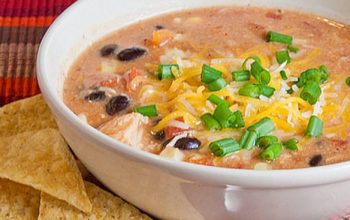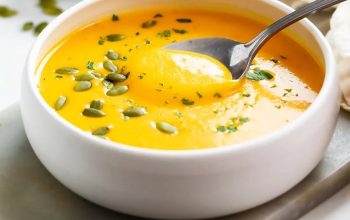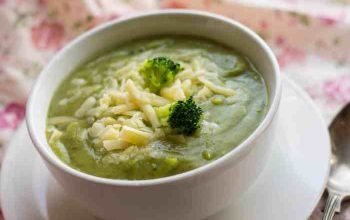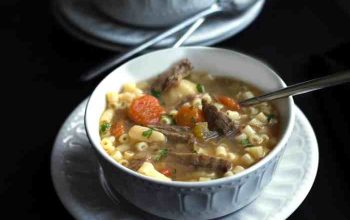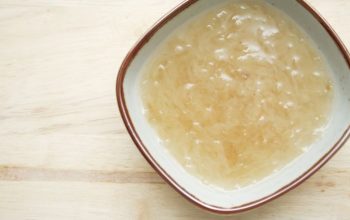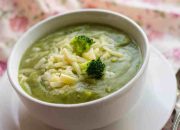Introduction to Russian Soups: Russian Soup Recipes
Russian soup recipes – Russian soups, or супы (supy), hold a central place in Russian cuisine, reflecting centuries of culinary tradition and cultural significance. They are more than just a meal; they represent comfort, hospitality, and a connection to the country’s rich history. The diverse geography and varied climates of Russia have led to a remarkable array of regional variations, each with its unique flavor profile and ingredient combinations.
Common ingredients across many Russian soups include root vegetables like potatoes, carrots, and beets; cabbage in various forms; herbs such as dill and parsley; and a variety of meats or mushrooms. The use of fermented ingredients, such as sauerkraut or kvass, adds a characteristic tanginess to many recipes. Regional differences often reflect the availability of local produce and traditional cooking methods passed down through generations.
Regional variations are significant. Soups from the northern regions might feature more fish and wild mushrooms, while those from the south might incorporate more tomatoes and peppers. The use of sour cream as a garnish is widespread, but specific herbs and spices can vary considerably based on local preferences.
Popular Russian Soup Types, Russian soup recipes
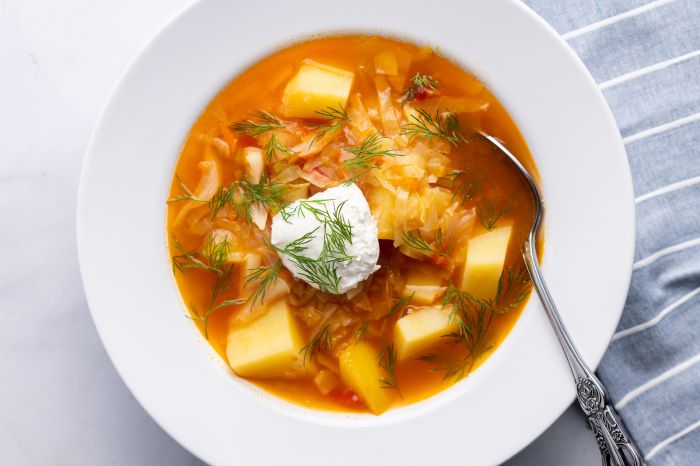
Source: thespruceeats.com
Several iconic Russian soups stand out for their popularity and distinctive characteristics. These include Borscht, Shchi, Okroshka, Rassolnik, and Ukha, each offering a unique culinary experience.
Borscht, a vibrant beetroot soup, is arguably the most internationally recognized Russian soup. Its variations are numerous, ranging from a rich, meaty version to lighter vegetarian options. Shchi, a hearty cabbage soup, is another staple, with variations based on the type of cabbage used (fresh, sauerkraut) and the addition of meats or mushrooms. Okroshka is a cold soup, typically served in summer, featuring vegetables, herbs, and a fermented kvass or yogurt-based broth.
Rassolnik is a sour soup often made with pickles and pearl barley, offering a unique and tangy flavor. Finally, Ukha is a traditional fish soup, typically made with various freshwater fish and often featuring dill and other herbs.
| Soup Name | Main Ingredients | Typical Serving Occasions | Regional Origin |
|---|---|---|---|
| Borscht | Beets, cabbage, potatoes, carrots, meat (beef, pork), onions | Everyday meals, special occasions | Ukraine and surrounding regions, widely consumed throughout Russia |
| Shchi | Cabbage, potatoes, carrots, onions, meat (beef, pork, chicken), mushrooms | Everyday meals, winter months | Throughout Russia, with regional variations |
| Okroshka | Vegetables (cucumber, radish, potatoes), herbs (dill, parsley), kvass or yogurt | Summer months, light meals | Throughout Russia |
| Rassolnik | Pickles, pearl barley, potatoes, meat (beef, chicken), onions | Everyday meals | Russia |
Ingredient Focus: The Role of Vegetables
Root vegetables – potatoes, carrots, and beets – form the backbone of many Russian soups, providing a foundation of flavor and texture. The earthy sweetness of carrots complements the richness of beets, while potatoes add a creamy consistency. Other vegetables like cabbage, onions, and cucumbers contribute additional layers of flavor and texture. The use of fresh versus fermented vegetables creates a significant difference in the final taste profile.
Fermented vegetables, such as sauerkraut, introduce a characteristic sourness and depth of flavor, contributing to the complexity of many traditional recipes.
A typical Russian soup might feature a vibrant array of vegetables. Imagine a medley of diced beets, their deep crimson hue contrasting with the pale yellow of potatoes and the bright orange of carrots. Shredded cabbage adds a textural element, while finely chopped onions and parsley provide aromatic complexity. Perhaps a few sprigs of dill add a fresh, herbaceous note, completing this colorful and flavorful ensemble.
Ingredient Focus: The Role of Meat and Broth
The choice of meat significantly impacts the taste profile of Russian soups. Beef, pork, and chicken are common choices, each imparting its unique flavor to the broth. A rich and flavorful broth is essential; it’s often simmered for hours to extract maximum flavor from the meat and bones. The process typically involves browning the meat before adding it to the simmering liquid, enhancing the depth of flavor.
The use of meat broth versus vegetable broth presents a key distinction. Meat broth provides a deep, savory flavor that complements the earthy tones of the vegetables. Vegetable broth, while lighter, can still create a delicious and hearty soup, particularly in vegetarian variations. The choice between the two depends on individual preferences and dietary restrictions.
Modern Interpretations of Russian Soup Recipes
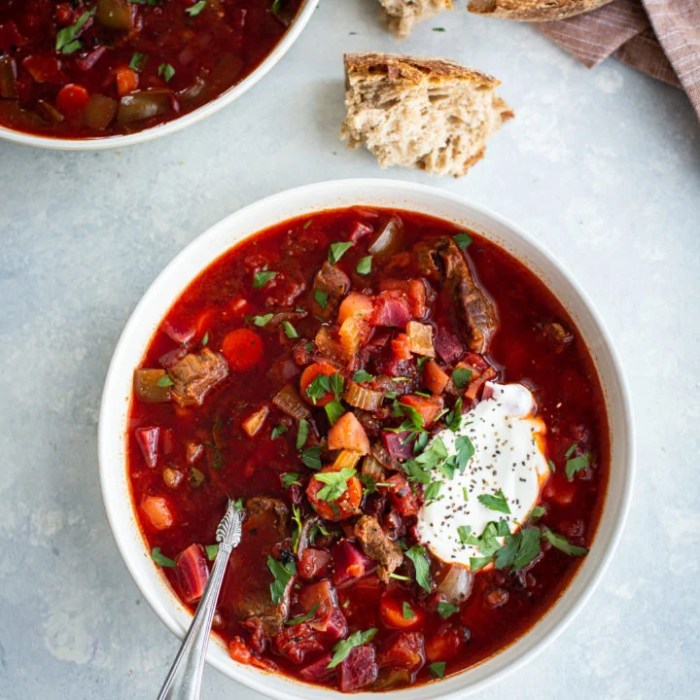
Source: goodlifeeats.com
Contemporary chefs are reimagining classic Russian soups, introducing innovative twists while respecting traditional techniques. Modern adaptations often involve incorporating global flavor profiles or using unusual ingredients within the framework of established recipes.
- Fusion soups: Combining Russian soup bases with Asian or Mediterranean influences.
- Vegan and vegetarian adaptations: Substituting meat with mushrooms, lentils, or tofu.
- Modern presentation techniques: Using innovative plating and garnishing methods.
- Experimentation with spices and herbs: Incorporating less traditional spices for unique flavor combinations.
- Use of locally sourced ingredients: Emphasizing seasonal and regional produce.
Serving and Accompaniments for Russian Soups
Russian soups are traditionally served in bowls, often accompanied by a dollop of sour cream, a slice of black bread, and sometimes a sprinkle of fresh herbs. The sour cream adds a creamy richness that balances the flavors of the soup, while the bread provides a comforting textural contrast. These accompaniments are not merely additions; they are integral to the overall dining experience, reflecting a deep-seated cultural significance.
- Borscht: Served hot in bowls, often garnished with sour cream and fresh dill.
- Shchi: Served hot in bowls, sometimes with a side of crusty bread and a dollop of sour cream.
- Okroshka: Served chilled in bowls, often with a side of chopped hard-boiled eggs.
- Rassolnik: Served hot in bowls, garnished with sour cream and chopped dill.
- Ukha: Served hot in bowls, often with a slice of lemon and fresh herbs.
Helpful Answers
Can I use frozen vegetables in Russian soups?
Absolutely! Frozen vegetables are a convenient alternative, just ensure they’re thoroughly thawed before adding them to the pot to prevent watering down the broth.
How long can I store leftover Russian soup?
Most Russian soups will happily last in the refrigerator for 3-4 days. Make sure to store them in airtight containers.
Are there vegetarian/vegan versions of Russian soups?
Yes! Many Russian soups, like shchi and borscht, can be easily adapted for vegetarian or vegan diets by omitting the meat and using vegetable broth.
What kind of bread is best served with Russian soup?
Hearty, crusty bread, like rye or black bread, is a classic accompaniment. It’s perfect for soaking up the delicious broth!

